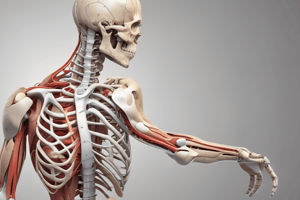Podcast
Questions and Answers
What is the main role of the rotator cuff in the shoulder?
What is the main role of the rotator cuff in the shoulder?
- To ensure mobility of the clavicle
- To stabilize the humeral head in the glenoid cavity (correct)
- To connect the humerus to the scapula
- To provide stability to the joint
Which structure connects the humerus to the scapula and collarbone in the shoulder joint?
Which structure connects the humerus to the scapula and collarbone in the shoulder joint?
- Middle glenohumeral ligament
- Coracohumeral ligament
- Rotator cuff (correct)
- Superior glenohumeral ligament
What type of joint is the shoulder joint (glenohumeral joint)?
What type of joint is the shoulder joint (glenohumeral joint)?
- Hinge joint
- Ball-and-socket joint (correct)
- Gliding joint
- Pivot joint
What are some common factors that can cause rotator cuff tears?
What are some common factors that can cause rotator cuff tears?
What is the main characteristic of frozen shoulder?
What is the main characteristic of frozen shoulder?
Which assessment measures the distance the arm can be raised laterally away from the body?
Which assessment measures the distance the arm can be raised laterally away from the body?
Which test is used to assess rotator cuff function?
Which test is used to assess rotator cuff function?
What is the purpose of manual therapy in treating shoulder injuries?
What is the purpose of manual therapy in treating shoulder injuries?
What is the main purpose of stretching exercises in shoulder injury treatment?
What is the main purpose of stretching exercises in shoulder injury treatment?
Which assessment measures the range of scapular elevation, depression, protraction, and retraction?
Which assessment measures the range of scapular elevation, depression, protraction, and retraction?
Flashcards are hidden until you start studying
Study Notes
Shoulder Region Assessment for Physical Therapists
The shoulder region is a critical area for physical therapists, as it plays a vital role in everyday activities, sports, and rehabilitation. Assessing and understanding the anatomy, common injuries, range of motion (ROM), special tests, and treatment planning for shoulder injuries are essential skills for any physical therapist.
Anatomy of the Shoulder
The shoulder joint, also known as the glenohumeral joint, is a ball-and-socket joint that connects the humerus (arm bone) to the scapula (shoulder blade) and clavicle (collarbone). The joint is surrounded by a complex network of muscles, tendons, and ligaments that ensure stability and mobility.
- Rotator cuff: A group of four muscles (supraspinatus, infraspinatus, teres minor, and subscapularis) and their associated tendons that stabilize the humeral head in the glenoid cavity.
- Ligaments: A group of fibrous bands, including the coracohumeral ligament, superior glenohumeral ligament, middle glenohumeral ligament, and inferior glenohumeral ligament, which provide stability to the joint.
Common Shoulder Injuries
Some common shoulder injuries that physical therapists encounter include:
- Rotator cuff tears: An injury to the rotator cuff muscles or tendons, often caused by repetitive overhead movements or sudden traumatic events.
- Shoulder impingement: A condition in which the rotator cuff tendons become pinched between the humeral head and the acromion process, causing pain and inflammation.
- Shoulder instability: A condition in which the humeral head dislocates from the glenoid cavity, commonly noted in anterior dislocations.
- Frozen shoulder: A condition characterized by stiffness, pain, and limited range of motion in the shoulder joint.
Shoulder Range of Motion Assessment
Assessing the shoulder's ROM is essential to determine the presence and severity of joint issues. Some standard measurements include:
- Forward flexion: The distance the arm can be raised forward without bending the elbow.
- Abduction: The distance the arm can be raised laterally away from the body.
- External and internal rotation: The distance the arm can be rotated externally and internally while keeping the elbow bent at 90 degrees.
- Scapular movement: The range of scapular elevation, depression, protraction, and retraction.
Special Tests for Shoulder Assessment
Various tests are used to identify specific shoulder injuries and conditions:
- Impingement tests: Such as the Hawkins-Kennedy test, Neer's test, and the cross-body adduction test to assess impingement.
- Rotator cuff strength testing: Such as the empty can test, drop arm test, and Jobe's test to assess rotator cuff function.
- Instability tests: Such as the anterior drawer test, load-and-shift test, and the sulcus sign to assess shoulder joint stability.
- Frozen shoulder tests: Such as the painful arc sign and the external rotation lag sign to assess frozen shoulder.
Treatment Planning for Shoulder Injuries
A well-rounded treatment plan includes:
- Manual therapy: Used to enhance joint mobility, decrease pain, and improve soft tissue mobility.
- Strengthening exercises: Designed to improve muscle strength and endurance to support joint stability.
- Stretching exercises: Designed to improve joint flexibility and range of motion.
- Functional training: Designed to help patients regain their ability to perform daily activities and sports-specific tasks.
- Education: Provided to ensure patients understand their injuries, treatment plans, and self-care strategies.
In summary, understanding the anatomy of the shoulder, common injuries, shoulder range of motion assessment, special tests for shoulder assessment, and treatment planning for shoulder injuries is essential for physical therapists. By using evidence-based techniques, PTs can help alleviate shoulder pain, restore joint mobility and function, while also providing education to patients to ensure long-term success.
Studying That Suits You
Use AI to generate personalized quizzes and flashcards to suit your learning preferences.




